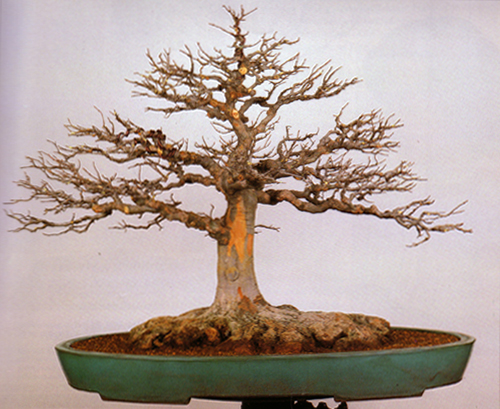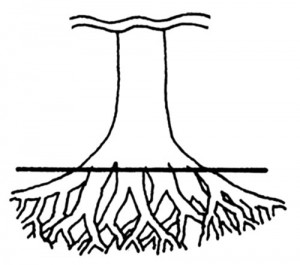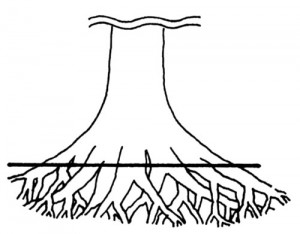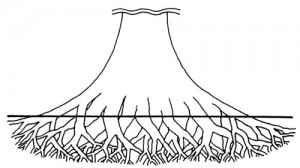
This rather nice looking Trident maple (Acer buergerianum) is sporting a monstrous nebari. Does it look a bit like a clown’s oversized shoes? Or does it suit your fancy just as it is? The original appears in Bonsai Today issue 70 in an article titled “Transplanting to increase the feeling of age,” by Kazunori Kamiya.
The graphics below are a continuation of the previous post (In search of the perfect nebari – part two). It is part of an article entitled Improving a Nebari by Oishi Kazo, that originally appeared in Bonsai Today issue 23 (out of print). It was later revised and republished in Bonsai Today issue 102.
 At first the roots are all beneath the soil.
At first the roots are all beneath the soil.
 As they thicken, you begine to see their tops…
As they thicken, you begine to see their tops…
 …until you have a fully developed nebari. However, example presupposes a perfect world. Normally, to get this kind of development, you need to begin to work on the nebari the first time you transplant.
…until you have a fully developed nebari. However, example presupposes a perfect world. Normally, to get this kind of development, you need to begin to work on the nebari the first time you transplant.
Stay posted for more on nebari development. Or, for the rest of this article, see Bonsai Today issue 102.
Part one of In Search for the Perfect Nebari is comprised of An Ingenious Technique parts one and two taken together. For the rest of In Search of the Perfect Nebari, see parts four & five.
The following is from Ray Figueroa. It appears under In Search of the Perfect Nebari – part two, but was meant to be here under part three.
You are, of course, correct that the nebari makes the tree. Without a good nebari, any bonsai looks like a stick in the ground. I’m glad you titled your article “In Search of the Perfect Nebari” because, like the bonsai itself, you never really get to the finished stage. Sadly, sometimes we lose sight of the target and we continue “running” past the finish line. In my opinion, the trident you show has be taken to far. That being said, it is definitely a wonderful work of art (I wouldn’t turn it down!)